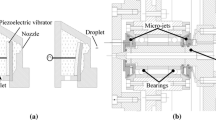Abstract
Due to the fast response, high precision and high working frequency, needle driven piezoelectric micro-jet devices have been applied in various industrial fields. The injection performance is important for the applications. The jetting velocity of the micro-droplets has a great influence on the ligament length and satellites. In this paper, the Fluent stimulation model of dynamic mesh motion has been established to simulate the jetting process. Meanwhile, the dependences of volume and jetting velocity of micro-droplets on input signal, including voltage, falling time, and fluid pressure, have been studied. The results show that the jetting velocity of micro-droplets can be changed and the volume is invariant by adjusting falling time, which can be used to guide the control of the needle driven piezoelectric micro-jet devices. Furthermore, the experimental system has been designed and the experiments show that the average minimum jetting velocity is about 0.724 m/s. The ligament length increases almost linearly with jetting velocity of the micro-droplets. And the optimal jetting velocity is less than 2.745 m/s, which cannot generate satellites.













Similar content being viewed by others
References
Allen EA, O'Mahony C, Cronin M, O'Mahony T, Moore AC, Crean AM (2016) Simulation and experiment on droplet formation and separation for needle-type micro-liquid jetting dispenser. Int J Pharm 500(1–2):1–10
Boehm RD, Jaipan P, Skoog SA, Stafslien S, VanderWal L, Narayan RJ (2016) Flow channel influence of a collision-based piezoelectric jetting dispenser on jet performance. Biointerphases 11(1):011008
Cheng E, Yu H, Ahmadi A, Cheung KC (2016) Influence of needle impact velocity on the jetting effect of a piezoelectric needle-collision jetting dispenser. Biofabrication 8(1):015008
Chu X, Zhong Z, Zhu C, Zhao Y, Li L (2016) A novel low-voltage non-resonant piezoelectric linear actuator based on two alternative principles. Ferroelectrics 505(1):147–158
Cinti S, Arduini F, Moscone D, Palleschi G, Killard A (2014) Development of an ultrasonic linear motor with ultra-positioning capability and four driving feet. J Sens (Basel) 14(8):14222–14234
Fuchiwaki Y, Yabe Y, Adachi Y, Tanaka M, Abe K, Kataoka M, Ooie T (2014) Investigation of the hydrodynamic response of cells in drop on demand piezoelectric inkjet nozzles. Sens Actuators A 219:1–5
Jiang J, Bao B, Li M, Sun J, Zhang C, Li Y, Li F, Yao X, Song Y (2016) Inkjet printing schwann cells and neuronal analogue NG108–15 cells. Adv Mater 28(7):1420–1426
Kai LI, Wei-Shan C, Le Y, Zhang AL (2016) Dissolvable microneedle fabrication using piezoelectric dispensing technology. J Electron Mater
Kim B-H, Kim S-I, Lee J-C, Shin S-J, Kim S-J (2012) Inkjet deposition of itraconazole onto poly(glycolic acid) microneedle arrays. Sens Actuators A 173(1):244–253
Kwon K-S, Choi Y-S, Lee D-Y, Kim J-S, Kim D-S (2012) Fabrication of transparent multilayer circuits by inkjet printing. Sens Actuators A 180:154–165
Lu S, Jiang H, Li M, Liu J, Gu S, Jiao X, Liu X (2015) Drops forming in inkjet printing of flexible electronic circuits. Smart Mater Struct 24(10):1
Lu S, Cao G, Zheng H, Li D, Shi M, Qi J (2018) Inkjet monitoring technique with quartz crystal microbalance (QCM) sensor for highly reproducible antibody immobilization. Micromachines (Basel) 9(7):330
Mogalicherla AK, Lee S, Pfeifer P, Dittmeyer R (2013) Development of a hydrogen peroxide sensor based on screen-printed electrodes modified with inkjet-printed prussian blue nanoparticles. Microfluid Nanofluid 16(4):655–666
Tomaszewski G, Potencki J (2017) Drop-on-demand inkjet printing of alumina nanoparticles in rectangular microchannels. Circuit World 43(1):13–18
Tse C, Whiteley R, Yu T, Stringer J, MacNeil S, Haycock JW, Smith PJ (2016) Generation of inkjet droplet of non-Newtonian fluid. Biofabrication 8(1):015017
Vadillo DC, Tuladhar TR, Mulji AC, Jung S, Hoath SD, Mackley MR (2010) Dynamic characteristics of a piezoelectric driven inkjet printhead fabricated using mems technology. J Rheol 54(2):261–282
Yang Y, Gu S, Lv Q, Liu J, Yang Z, Li C, Tian H (2019) Low-cost and high speed monitoring system for a multi-nozzle piezo inkjet head. Sens AIP Adv 9(4):160436
Yoo H, Kim C (2013) Evaluation of the inkjet fluid’s performance using the “Cambridge Trimaster” filament stretch and break-up device. Rheol Acta 52(4):313–325
Zhou C, Deng G, Li J, Duan JA (2018) Research on the injection performance of a novel lubricating device based on piezoelectric micro-jet technology. Sensors 18(4):1270
Zhu C, Chu X, Yuan S, Zhong Z, Zhao Y, Gao S (2016) Nozzle and needle during high viscosity adhesive jetting based on piezoelectric jet dispensing. Ultrasonics 72:66–72
Acknowledgements
This work was financially supported by the National Natural Science Foundation of China (Grant no. 51775304). The authors acknowledge the support of Paihe Science & Technology for providing the experimental equipment.
Author information
Authors and Affiliations
Contributions
All authors conceived and designed the experiments and analyzed the data; all authors contributed to the writing of the paper.
Corresponding author
Ethics declarations
Conflict of interest
The authors declare no conflict of interest.
Additional information
Publisher's Note
Springer Nature remains neutral with regard to jurisdictional claims in published maps and institutional affiliations.
Rights and permissions
About this article
Cite this article
Sun, C., Chu, X., Yan, S. et al. Influence of input signal on injection performance for needle driven piezoelectric micro-jet device. Microsyst Technol 27, 2009–2019 (2021). https://doi.org/10.1007/s00542-020-04991-7
Received:
Accepted:
Published:
Issue Date:
DOI: https://doi.org/10.1007/s00542-020-04991-7




